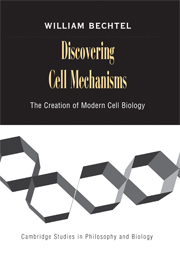Book contents
- Frontmatter
- Contents
- Preface
- 1 Introduction: Cell Mechanisms and Cell Biology
- 2 Explaining Cellular Phenomena through Mechanisms
- 3 The Locus of Cell Mechanisms: Terra Incognita between Cytology and Biochemistry
- 4 Creating New Instruments and Research Techniques for Discovering Cell Mechanisms
- 5 Entering the Terra Incognita between Biochemistry and Cytology: Putting New Research Tools to Work in the 1940s
- 6 New Knowledge: The Mechanisms of the Cytoplasm
- 7 Giving Cell Biology an Institutional Identity
- Afterword
- References
- Index
3 - The Locus of Cell Mechanisms: Terra Incognita between Cytology and Biochemistry
Terra Incognita between Cytology and Biochemistr
Published online by Cambridge University Press: 05 June 2012
- Frontmatter
- Contents
- Preface
- 1 Introduction: Cell Mechanisms and Cell Biology
- 2 Explaining Cellular Phenomena through Mechanisms
- 3 The Locus of Cell Mechanisms: Terra Incognita between Cytology and Biochemistry
- 4 Creating New Instruments and Research Techniques for Discovering Cell Mechanisms
- 5 Entering the Terra Incognita between Biochemistry and Cytology: Putting New Research Tools to Work in the 1940s
- 6 New Knowledge: The Mechanisms of the Cytoplasm
- 7 Giving Cell Biology an Institutional Identity
- Afterword
- References
- Index
Summary
Until these ‘accidents’ occurred, workers engaged in the exploration of living organisms had been forced to stop at the edge of a mysterious no-man's-land, bounded at the upper level of the dimension scale by the resolving power of the light microscope, and at the lower level by the applicability of chemical techniques. They knew, in a frustrating sort of way, that the area between these two boundaries contained some of the essential clues without which life would remain forever ununderstandable. With the technical advances mentioned, this region suddenly became accessible, both to visual examination right down to the level of macromolecules, and to chemical separation and analysis right up to the level of microscopic entities.
(de Duve, 1963–4, pp. 49–50)Having described in abstract terms what mechanisms are and how they figure in scientific explanation, I turn now to setting the stage historically for the contributions of cell biology. The project of identifying cell mechanisms began in earnest after 1940 in what was then unoccupied territory between cytology and biochemistry. Researchers were at best dimly aware that crucial cellular operations occurred in organelles for which no direct methods of investigation were available. These organelles were too small to be meaningfully examined with the light microscope and much larger than the reacting molecules in homogenates that biochemists prepared from broken cells.
- Type
- Chapter
- Information
- Discovering Cell MechanismsThe Creation of Modern Cell Biology, pp. 64 - 117Publisher: Cambridge University PressPrint publication year: 2005



